Who are the Mardi Gras Indians?
by angeliska on April 5, 2006
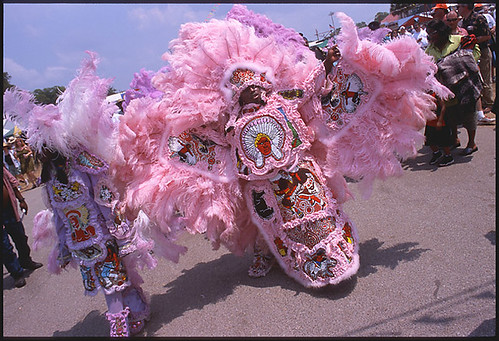
I recently became aware that many people I’ve met here have never heard of the Mardi Gras Indians. Blank stares and misconceptions run rampant when the subject comes up, sadly – as this is a major part of New Orleans culture, and a tradition not found anywhere else. Rarely have I seen anything so inspiring and beautiful.
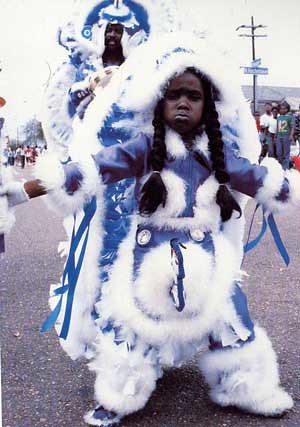
In the early 1800’s most poor African-American citizens were banned from attending the Mardi Gras Balls held by usually all-white or Creole “Krewes.” These secret society organizations were devoted to putting on elaborate costumed celebrations and parades. Until the 1960’s, it was illegal (during Carnival time) for African-Americans to enter the French Quarter, congregate, or parade on the main streets. It was also against the law for a black person to “mask” or hide their identity behind a costume. But meanwhile, in the poor neighborhoods where the law normally did not bother to police during busy Carnival season, a unique way of celebrating Mardi Gras was forming. Social Aid and Pleasure Clubs formed within neighborhoods to act as mutual aid societies, provided insurance and health care. They also sponsored funerals for passed members that involved a walking brass brand following the funeral carriage, and a “second line” of dancing paraders behind. The jazz dirges the band played would become more joyful on the way back from the cemetery. Eventually the second liners decided they didn’t need a funeral (or anyone’s permission) to parade the neighborhoods. This is what they did, nearly every Sunday morning- (and what they still do- at least, until Katrina.) The Mardi Gras Indians evolved from a deep respect and desire to pay homage to the memory of the Choctaw and Seminole Indians. The tribes aided countless African slaves in their escape from the tyranny of slave owners. Many of the escaped slaves vanished into the bayous and swamps, where they joined Native American tribes, often marrying and syncretizing their cultures and beliefs. For two centuries, a bond was kept alive between these two cultures- both oppressed by the white presence in Louisiana, and both possessing a common reverence for the earth, their ancestors, seasonal ritual and ceremony. Many of the slaves in New Orleans were taken from Nigeria, where traditionally members of visiting tribes would show respect to their hosts by donning their ceremonial costumes at ritual celebrations. Another theory about the roots of this tradition follow its beginning to the Buffalo Bill Wild West Shows of the 1800’s, which might have given some shape and vision to an idea of Native Americans that previously were only passed down in oral tradition. The “masking Indian” tradition began as a reenactment of the “warpath” mode as a way of staking out turf, or territory and challenging and “settling scores” with adversary tribes. The Uptown and Downtown districts of New Orleans were populated by groups of West Indian and African descent, and who apparently had nothing but disdain for each other. This resentment would manifest itself in violent outbreaks. Shootouts and knife or hatchet fights were not uncommon, and Mardi Gras day became known by the Indians as a day for revenge. Between the late 1940’s and the 1960’s violence had begun to take its toll: a new way of continuing the competition arose- the most beautiful and elaborate costume, the best singers, and the most skilled dancers would walk away from a confrontation victorious.
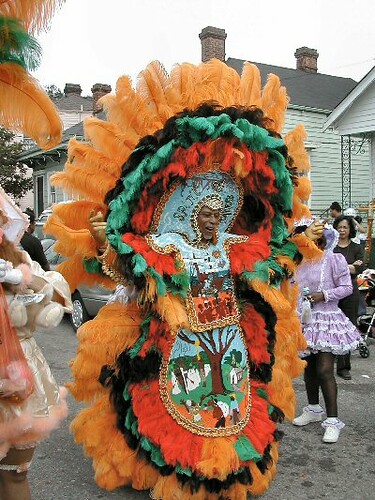
The intricately beaded, bejeweled and brightly feathered “suits” are painstakingly created by each Mardi Gras Indian. They are a stunning visual manifestation of expression as well as a form of nonverbal communication. The beadwork (especially of the Uptown Indians) is more evocative of the Yoruba people of Nigeria than of any traditional Native-American style. The images they depict, however, show symbols and tell stories from Native-American cosmology: depicting the buffalo, hawk, eagle, arrows, and images of the brave in varied aspects of life. These beaded panels, story boards, flaps, and aprons are gestured to and revealed in the challenging dance. The accompanying chants describe the images and show off their craftsmanship simultaneously. The call-and-response chant and singing style is also traditionally African- the words a blend of street slang, Kreyol patois, and many phrases whose original root and meaning has been lost. This unique cult language has been very difficult to retrieve via oral sources. Mysterious phrases such as, “Two-Way-Pocky-Way” have been repeated and remembered from one generation to the next as part of the confrontational procession. The text from Allan Lomax’s book Mister Jelly Roll reveals “The Kreyol spelling as ‘T’ouwais, bas q’ouwais’ and response ‘Ou tendais,’ though there have been other representations. One possible translation of the phrase is ‘I’ll kill (tuez) you if you don’t get out the way, ‘ with the response ‘Entendez,’ or ‘I hear ya!’” Percussive instruments, such as tambourines, drums, cowbells and other makeshift instruments are “called” by the big chief as accompaniment. The response is led by the tribe, and the group of enthusiastic followers who cheer and sing out the glory of the fierce and majestic Indians. These songs, although similar are rarely sung in just the same way by all the tribes, though they lay claim to the same repertoire. The tempo may be fast or relaxed depending upon the mood of the singers, but it remains consistent throughout the song.
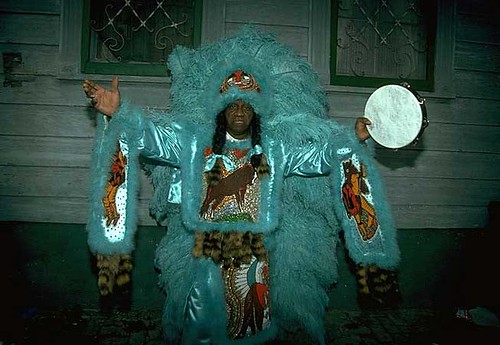
On Mardi Gras day St. Joseph’s Day and Super Sunday, with some other appearances during the year (including during JazzFest), neighborhood tribes display their dazzling, colorful costume artistry. The “main force” tribes move through the community in an informal competition led by the tribe’s “Spy-Boy” or “Spy-Girl.” These warrior-scouts are dressed in “running suits,” lighter, less elaborate costumes, fashioned to allow the wearer to move quickly if necessary. These scouts are not always young, as their title might indicate- older, more experienced Indians are often chosen for their abilities in “reconnaissance and evasion.” Next comes the “First Flag”, or standard bearer, which is usually a staff or totem held high and emblazoned with the tribe’s name and symbols. Then the “Medicine Man” (who naturally holds the role of spiritual advisor), the “Second Flag” (the big chief’s personal scout), the “Wild-Man” (bodyguard to the chief), “Lil’ Chief” (who is usually a young male heir to the chief hood, learning and being groomed to take over eventually). After these follow the “Big Queen” who stays near to the chief and serves as his primary advisor. Finally comes the, “Big Chief”. He directs the tribe and the march and decides whom to “engage” and whom to “ignore”. Immediately following the Big Chief, in other tribes you may see a 2nd or 3rd chief. These “second-in-line” are there for back up and protection, as well as for continued leadership if anything should befall the Big Chief. The tribe is then followed by the band or simply a percussion section. One by one, dancing in toe/heel fashion, each member of a tribe meets his counterpart for an individual challenge, and all meet and play out their traditional roles. Finally one big chief faces another. Knees bent, arms outspread, swaying from foot to foot, and turning in a circular motion the chiefs slowly size each other up. This preening proves especially effective for showing off the costumes. Prestige for the tribe is garnered through the beauty and intricacy of the suits and the power and confidence of an experienced chief. Because the tribes have no set routes for their day’s “journeys” whether they meet each other, or not, is often entirely a matter of chance. When opposing tribes meet, there is dancing and general “showing off,” all with a shared pride in “suiting up Indian.” Participants in this street theater of confrontational posturing, role-playing, music, costume and dance are enacting an ancient ritual- at once honoring the indigenous tribes of America as well as (if not more so) their own African ancestral legacy. The original words are difficult to trace, but today the primary function is assertive peer-group bonding.
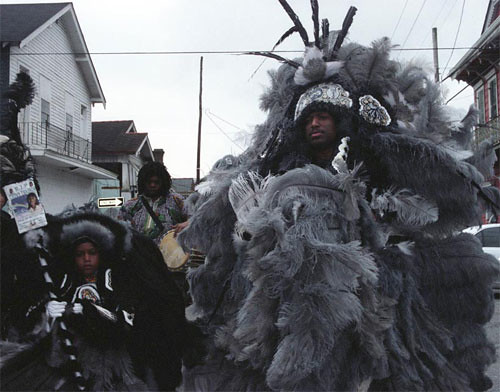
In the words of Big Chief Larry Bannock (of the Golden Star Hunters), “Mardi Gras Indians is the parade most white people don’t see.” The “secret society” nature of the tribes, and their “underground” status in the Carnival celebration have led to this ethnic culture becoming marginalized. The high cost and intensive labour required of making a costume can be prohibitive in a community where poverty is the norm (where creation of one year’s costume can cost thousands of dollars). Hassling from police and local government, fines, and exorbitant permit fees have led to concerns about the tradition’s ability to survive. The elderly chiefs who know the old ways and oral traditions are dying out. This last stand of psuedo-tribal culture in an urban setting seems destined to become a thing of the past- especially since Hurricane Katrina virtually wiped out entire neighborhoods where these vibrant ceremonies took place. This Mardi Gras and Super Sunday proved that the tribes will indeed survive, literally hell or high water- as Big Chief Larry said this year, “All it takes is one Indian on the corner and we’re going to survive,”

Photographs by Christopher Porche West and Michael P. Smith.


One comment
[…] If the Bone Gangs get you up and at ‘em, you can go out and chase some Mardi Gras Indians, first thing. This year the Young Seminole Hunters were looking very pretty indeed. Don’t know what that’s all about? Check out this piece I wrote a few years back: Who are the Mardi Gras Indians? […]
by All On a Mardi Gras Day « Angeliska Gazette on February 23, 2013 at 8:21 pm. #